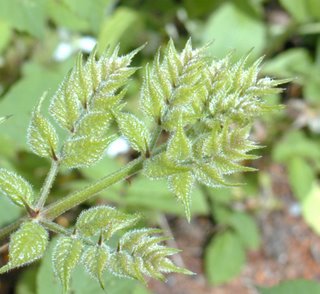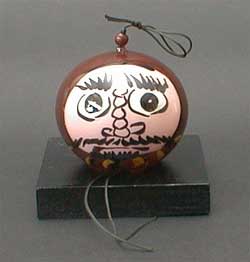:::::::::::::::::::::::::::::::::::::::::::::::::::::::::::::::::::::::::::::::::::::::::::::::::::::
The words LEAF, LEAVES, ha, happa 葉、葉っぱ Blatt, Blätter,
refering to the leaves of trees,
just like that are not a kigo.
But special kinds of tree leaves come in various seasons, check the kigo below and the links for the other seasons.
We even have "fallen leaves" in more than one season.
Young green leaves have the full power of life and branches with them were a favorite with the ladies of old to stick into the hair, thus partaking of this natural power.
Thhis custom later turned into elaborate
. kanzashi 簪 hairpins .
quote
Ashiki no yama no konure no hoyo torite kazashitsuraku wa chitose hoku to so
Taking the mistletoe from the top of the mountain and placing it in my hair,
wanting to celebrate a thousand years.
Oomoto no Yakamochi
Haruo Shirane
source : books.google.co.jp
:::::::::::::::::::::::::::::::::::::::::::::::::::::::::::::::::::::::::::::::::::::::::::::::::::::
SPRING
kigo for mid-spring
kashiwa ochiba 柏落葉 (かしわおちば) fallen leaves of oak trees
..... kashiwa chiru 柏散る(かしわちる)
kigo for late spring
kusa no wakaba 草の若葉 (くさのわかば) young leaves of plants
..... kusa wakaba 草若葉(くさわかば)
wakakusa 若草 young plants, young grass
..... wakakusa 嫩草(わかくさ)
niikusa 新草(にいくさ)new plants, new grass
kusa wakashi 草若し(くさわかし)plants/grass is young
wakakusa no 若草野(わかくさの)plain with young plants/grass
kusa can be all kind of small plants and weeds
. ashi no wakaba 蘆の若葉(あしのわかば)
young leaves of reed grass .
haru ochiba 春落葉 (はるおちば) fallen leaves in spring
..... haru no ochiba 春の落葉(はるのおちば)
:::::::::::::::::::::::::::::::::::::::::::::::::::::::::::::::::::::::::::::::::::::::::::::::::::::
SUMMER
Young Leaves (wakaba)
***** Season: Early Summer

.........................................
young leaves, fresh leaves, wakaba 若葉
new leaves
fresh green leaves, fresh verdure
wind in the young leaves, wakaba kaze 若葉風
rain on the young leaves, wakaba ame 若葉雨
young leaves in the mountains, yama wakaba 山若葉
young leaves in the in the local villages (one's home .. see furusato)
..... sato wakaba 里若葉
young leaves in the valley, tani wakaba 谷若葉
young leaves in the garden, niwa wakaba 庭若葉
young leaves outside of the window, mado wakaba 窓若葉
wakabadoki 若葉時(わかばどき)time for young leaves
Wakaba, this kigo stressed the softness and suppleness of the young leaves, whereas the next one, aoba, stresses the color.

Photo Gabi Greve
Some trees have their own kigo with the young leaves
. hayanagi 葉柳 (はやなぎ) leaves of the willow tree .
young persimmon leaves, kaki wakaba
柿若葉(かきわかば)
pasania; chinquapin young leaves, shii wakaba
椎若葉(しいわかば)
young oak leaves, kashi wakaba
樫若葉(かしわかば)
..... kashi shigeru 樫茂る(かししげる)
young camphor tree leaves, kusu wakaba
樟若葉(くすわかば)
young leaves of the maple tree, wakakaede, waka kaede
若楓 (わかかえで)
..... kaede wakaba 楓若葉(かえでわかば)
..... aokaede, ao kaede青楓(あおかえで)
(they turn to momiji in autumn)
:::::::::::::::::::::::::::::::::::::::::::::::::::::::::::::::::::::::::::::::::::::::::::::::::::::
green leaves, aoba 青葉 (あおば)
green and young leaves aobawakaba 青葉若葉(あおばわかば)
mountain with green leaves, aoba yama 青葉山(あおばやま)
fresh, new green, shinryoku 新緑 (しんりょく)
green, midori 緑(みどり)
green is showing, midori sasu 緑さす(みどりさす)
hazakura 葉桜 (はざくら) leafy cherry tree
..... wakaba no hana 若葉の花(わかばのはな)
..... aoba no hana 青葉の花(あおばのはな)
kigo for the late cherry blossoms among the green leaves
musubiba 結葉 (むすびば) "leaves tied together"
when the new leaves grow thickly and look like tied up.
.................................................................................
tokiwagi no ochiba (tokiwa no ki no ochiba)
常磐木落葉 (ときはぎのおちば)
fallen leaves of evergreen trees
. shii ochiba 椎落葉(しいおちば)fallen leaves of the Shii-oak .
..... kashi ochiba 樫落葉(かしおちば)fallen leaves of the Kashi-oak
. kusu ochiba 樟落葉(くすおちば)fallen leaves of the camphor tree.
hiiragi ochiba 柊落葉(ひいらぎおちば)
fallen leaves of the holly
..... mochi ochiba 冬青落葉(もちおちば)
Ilex pedunculosa
mokkoku ochiba 木檞落葉(もっこくおちば)fallen leaves of the mokkoku tree
Ternstroemia gymnanthera, Japanese Cleyera
. tsuge ochiba 黄楊落葉(つげおちば)
fallen leaves of boxwood .
momi ochiba 樅落葉(もみおちば)fallen needles of a fir tree
hinoki ochiba 檜落葉(ひのきおちば)fallen leaves of the Japanese cypress
Chamaecyparis obtusa
The leaves are scale-like, 2-4 mm long, blunt tipped (obtuse), green above, and green below with a white stomatal band at the base of each scale-leaf.
© More in the WIKIPEDIA !
. Hinoki cypress 桧、檜 .
. fallen leaves of bamboo, take ochiba 竹落ち葉 .
..... take no ochiba 竹の落葉
young leaves of bamboo, take no wakaba 竹の若葉(たけのわかば)
take no wakamidori 竹の若緑(たけのわかみどり) young green of the bamboo
.................................................................................
other categories with "aoba - leaves"
. aobajio 青葉潮 (あおばじお) tide and green leaves .
. aobagoe 青葉肥(あおばごえ) green leaves as fertilizer .
. Aoba matsuri 青葉祭 (あおばまつり)
"Festival of the Green Leaves" .
. aobazuku 青葉木莵 "owl in green leaves" .
Otus scops japonicus
:::::::::::::::::::::::::::::::::::::::::::::::::::::::::::::::::::::::::::::::::::::::::::::::::::::
kigo for mid-summer
. "peach leaf red", tooyookoo 桃葉紅(とうようこう) .
Oleander (Nerium oleander)
:::::::::::::::::::::::::::::::::::::::::::::::::::::::::::::::::::::::::::::::::::::::::::::::::::::
kigo for all summer
banryoku 万緑 (ばんりょく) a myriad of green (leaves)
ryokuin 緑陰 (りょくいん) green shade
aobayami 青葉闇(あおばやみ)shade, darkness under the green leaves
shigeri 茂 - 繁り (しげり) leaves grow thick
shinmo 繁茂(はんも)
shigeru 茂る(しげる)to grow thick (of leaves and plants)
shigeshi 茂し(しげし)
shigemi 茂み(しげみ)thicket
shigeyama 茂山(しげやま)mountain with thicket
shigeno 茂野(しげの)wilderness with thicket
shigeriba 茂り葉(しげりば)thicket of leaves
..... morin 、茂林(もりん)
kusa shigeru 草茂る(くさしげる) plants grow thick
:::::::::::::::::::::::::::::::::::::::::::::::::::::::::::::::::::::::::::::::::::::::::::::::::::::
kigo for late summer
wakuraba 病葉 (わくらば)
sickly leaves, pale leaves, weak leaves
:::::::::::::::::::::::::::::::::::::::::::::::::::::::::::::::::::::::::::::::::::::::::::::::::::::
AUTUMN
. red autumn leaves, momiji 紅葉 (もみじ)
yellow leaves, colored leaves
red maple leaves, red autumn leaves
and many related kigo
:::::::::::::::::::::::::::::::::::::::::::::::::::::::::::::::::::::::::::::::::::::::::::::::::::::
WINTER
Fallen leaves (ochiba 落ち葉)
momiji chiru 紅葉散る (もみじちる)
chiri mojiji 散紅葉(ちりもみじ)
and kigo related to the fallen leaves
leaves of trees, ko no ha 木の葉
. kareha 枯葉 (かれは) withered leaves .
.................................................................................
kigo for early winter
fuyu momiji 冬紅葉 (ふゆもみじ) red leaves in winter
nokoru momiji 残る紅葉(のこるもみじ)red leaves still left over
*****************************
Worldwide use
Europe
Young leaves of the Beech tree (Fagus sylvatica)
:::::::::::::::::::::::::::::::::::::::::::::::::::::::::::::::::::::::::::::::::::::::::::::::::::::
North America
Watching the Japanese maple tree leaf out is one of the things I anticipate
each spring.
The whole cycle is a joy.
new maple leaves ~
Joys of Japan find their way
to Tacoma
Elaine Andre, Tacoma
*****************************
Things found on the way
happa bijinesu 葉っぱビジネス "leaf business"
. Decorating food with leaves .
*****************************
HAIKU
nekorobeba hara no ue made wakaba kana
lying on my back
on the ground -- new leaves
even on my stomach
Tr. Chris Drake
This summer hokku is from the 6th month (July) of 1814, two months after Issa had gotten married to a woman who lived near his hometown. Issa seems to be in a very good mood, and he decides to just lie down on his back on the ground and stretch out for a while, probably just to enjoy things. (The next hokku in his diary is about looking up at clouds.) He seems to be near some bushes or a low tree or two, because there are new green leaves stuck to his robe, even on the part over his abdomen. He seems surprised by the leaf or leaves on his upper side, since he's lying on his back.
Most of the leaves on the ground are old leaves, however, so Issa's robe must have picked up the new green leaves when he was flopping down onto the ground and stretching out. Or perhaps the low limb of a leafy bush is lying across his abdomen area. Is Issa momentarily imagining he's a plant? Or could this be a rejuvenation or fertility image suggesting marital lovemaking?
Chris Drake
. WKD : Kobayashi Issa 小林一茶 in Edo .
:::::::::::::::::::::::::::::::::::::::::::::::::::::::::::::::::::::::::::::::::::::::::::::::::::::::

How ethereal
the sunlight
through young leaves
Basho
Haiga by Soji
http://www.haikupoetshut.com/
Soji took the picture in early May, which is considered Mid-Spring in his area of America.
xxxxxxxxxxxxxxxxxxxxxxxxxxxxx
furu kaki no shiyooji nashi no wakaba kana
on the old fence
to no avail...
fresh leaves
wakaba shite mata mo nikumare enoki kana
fresh leaves again
make it hateful...
nettle-tree
wakaba shite neko to karasu to kenka kana
fresh new leaves--
the cat and the crow
quarrel
Issa
Read more of Issa's haiku on the subject here:
http://haikuguy.com/issa/
take no ha ni tsurete mugura mo wakaba kana
keeping bamboo shoots
company, weeds
fresh green too
Issa
Issa and Wakaba Haiku
:::::::::::::::::::::::::::::::::::::::::::::::::::::::::::::::::::::::::::::::::::::::::::::::::::::
あらたふと青葉若葉の日の光
ara tooto aoba wakaba no hi no hikari
“How noble it is with bright sunshine on green foliage and young foliage !”
Read more here !
Matsuo Basho in Nikko

:::::::::::::::::::::::::::::::::::::::::::::::::::::::::::::::::::::::::::::::::::::::::::::::::::::
. Green Leaves Haiku at Kifune Shrine
Kyoto
*****************************
Related words
***** . TREES in all seasons
***** Green in Haiku Traditional Japanese Colors: midori, aoi
.................................................................................
just one leaf
and so many kigo -
Joys of Japan
- Shared by Gabi Greve
just one leaf
and so many Joys
branches of willow
Gennady Nov
Joys of Japan, 2012
:::::::::::::::::::::::::::::::::::::::::::::::::::::::::::::::::::::::::::::::::::::::::::::::::::::
[ . BACK to DARUMA MUSEUM TOP . ]
[ . BACK to WORLDKIGO . TOP . ]
:::::::::::::::::::::::::::::::::::::::::::::::::::::::::::::::::::::::::::::::::::::::::::::::::::::

























